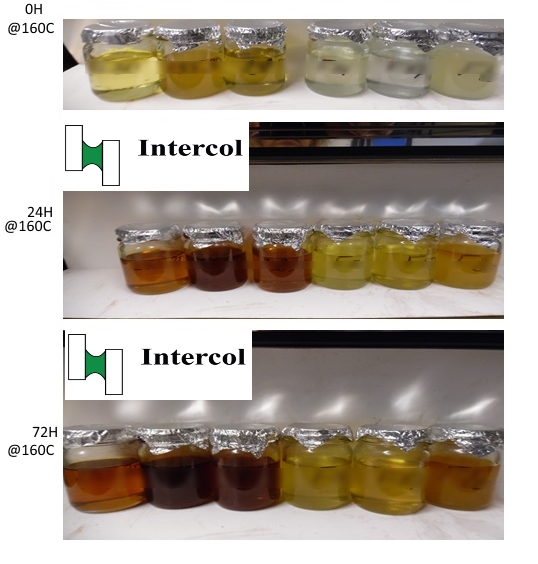Heat Stability of Hot-Melt Adhesives
Hot-melt adhesives are most applied at relatively  high temperatures, between 140°C and 180°C (Average 160°C). In these temperature ranges the viscosity is low enough to be processeed in typical hot-melt equipment (Nordson®, Robatech®, Melton®, ITW Dynatec®, UES®, Meler®) .
high temperatures, between 140°C and 180°C (Average 160°C). In these temperature ranges the viscosity is low enough to be processeed in typical hot-melt equipment (Nordson®, Robatech®, Melton®, ITW Dynatec®, UES®, Meler®) .
Hot melt adhesives do change because of high temperatures, temperature and time are main factors. Especially above temperatures of 160 degrees celcius, hot melt adhesives will degrade faster, become brown, black, coaled, and lower in viscosity because chemical chains break down.
Burned hotmelt adhesive may disrupt manuacturing processess by clogging the adhesive system, and may affect the quality of the adhesive bond. Both, cohesion and adhesion may be less strong. Changes in hotmelt adhesive's viscosity may affect the quantity of adhesive dispensed by the applicator, a non contact jetting, wheel, spray, etc. . Phase separation (black/brown layers onto transparent adhesive) or changes in viscosity and color may be an indication of hot melt ageing/burning/coaling. A skin formed on the adhesive in the buffer hot melt tank may eventually clog the applicator nozzle or die.
At Intercol we have a simple but effective test procedure, and we always compare several adhesives in one single test, most at 160 Degrees Celsius, but these may be other circumstances, likely to the end user circumstances or requirements. Sometimes hot melt is tested for determining batch-to-batch variation or as mentioned, relative thermal stability of alternate adhesive formulations, these may be competitor products as well. Well thermal stable, clean hotmelts, reduce maintenance on application equipment and establishe more effective operating conditionsin for example packaging processes.
Heat stability of several based adhesives technologies, like EVA copolymer, polyolefin, or polyamide may be very different
Intercol's test method simulates and determines the change in properties of hot-melt adhesives in the molten state in a tank, all the way during hot-melt application by e.g. non contact nozzles. Properties monitored are viscosity, color, cohesion, skin formation, adhesion, bonding strength and phase separation.
Using thermal stable hot melt adhesives support safety in our customers manufacturing process. It is the responsibility of the user of our adhesives to establish appropriate safety and health practices and determine the applicability of regulatory limitations, and our adhesives prior to use.




